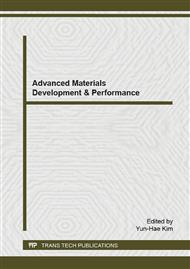p.158
p.163
p.169
p.173
p.179
p.185
p.191
p.197
p.203
Polarization Characteristics to Wear Ratio of Anti-Fouling Paint
Abstract:
Recently, anti-fouling paints which does not include the poison components such as tin (Sn) free, copper (Cu) free have been increasingly developed in order to decrease the contamination of marine environment. Moreover, the wear ratios of these anti-fouling paints are very important problem to prolong their life time in economical and environmental point of view. In this study, four types of anti-fouling paints as self-polishing type were investigated on the relationship between their polarization characteristics and wear ratios. Relationship between wear ratio and variation ratio of polarization resistance measured in corrosion potential was not well matched with each other. However, there was a good agreement between the wear ratio and variation ratio of diffusion limiting current density, for example, the higher or the lower variation ratio of diffusion limiting current density, wear ratio also increased or decreased respectively. Consequently, it is suggested that we can qualitatively expect the life time and wear degree of anti-fouling paint by only measuring the polarization characteristics before the wear test is practically performed in the field.Keywords: Anti-fouling paint, Self-polishing type, Polarization characteristics, Wear ratio, Diffusion limiting current density, Corrosion Potential
Info:
Periodical:
Pages:
179-184
Citation:
Online since:
June 2015
Authors:
Price:
Сopyright:
© 2015 Trans Tech Publications Ltd. All Rights Reserved
Share:
Citation:


